By François-Nicolas Robinne
In May 2016, the Horse River fire in Fort McMurray burned approximately 600,000 ha and reminded us, with its many acres of boreal forest, Alberta can be a fire-prone region (Figure 1). The boreal forest ecosystem, due to its vegetation characteristics, is conducive to fire. If one feels a bit nerdy on a snowy Canadian weekend and wants to spent some time looking at satellite images provided by NASA, you would rapidly see there is always a fire burning somewhere in the world.
What is important to bear in mind is that, for better or for worse, vegetation fires are an essential part of landscape function and development. However, fire also impacts some ecosystem services (the benefits human communities can get from nature) which often translates into a myriad of issues.

Figure 1: The Athasbasca River valley after the Horse River fire, near Fort McMurray (Credit: X. Cai, University of Alberta, Sept. 2016)
Known impacts to ecosystem services
Two ecosystem services provided by healthy forests are filtration of precipitation water and erosion control, both of which are important to human communities[1].
The way a wildfire usually impacts surface freshwater supplies follows a general course. The combustion of above-ground vegetation and litter produces ash and can release heavy metals and nutrients previously tied up in the vegetation and soil (Figure 2).
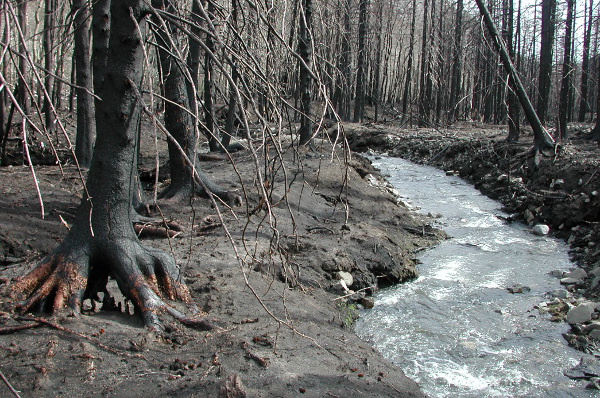
Figure 2: A creek after the Lost Creek fire, Alberta, 2003 (Credit U. Silins, University of Alberta, 2004)
Heat from combustion also alters soil structure decreasing soil stability and soil water-infiltration capacities. When rain falls the absence of vegetative cover allows water to wash over the ground surface as excess runoff. This runoff exerts a great erosive power on unprotected soils, carrying sediments, chemicals, debris, and ashes to the stream network (Figure 3).
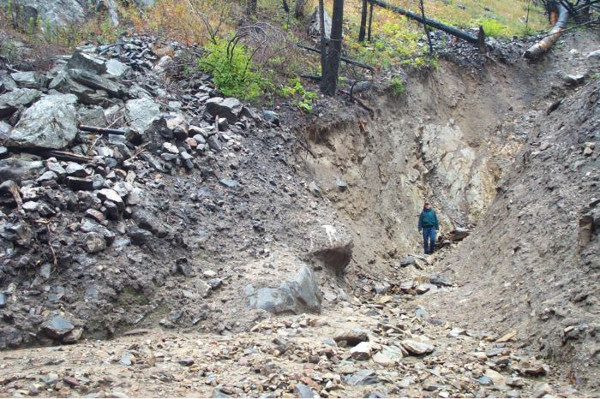
Figure 3: Burned hillslope that has been eroded down to bedrock near Sula, Montana.
All that sediment was moved off the hillslope and into the stream (Credit: Istituto di Ricerca per la Protezione Idrogeologica, 2016)
An increase in run-off, coupled with release of debris and nutrients, can alter water quantity and quality.
The degree to which fire affects water and soil is also a function of fire severity, the timing and intensity of post-fire rainfalls, and topography. As such, a severe wildfire in a steep terrain followed by a rainstorm would be the worst scenario in terms of post-fire hydrologic hazards.
More on this topic can be found in a reference report from the US Department of Agriculture[2].
Emerging research in post-fire hydrological hazards
The science of post-fire hydrology has been around for decades, mostly led by researchers from USA, Australia, South-Africa, Portugal, and Canada. Hundreds of publications have focused on the complexity and diversity of responses of small-to-large watersheds to flames in different environments. In some cases, results show changes in pollutant loads can reach more than a thousand times the pre-fire values, sometimes for several years after the blaze[3].
Nevertheless, the number of studies specifically dealing with post-fire hydrologic hazards and downstream risks to communities remains fairly low. Attention to this specific topic has only been growing for a decade or so: the notion of watershed-wildfire risk was further explored in 2013[4]. This was followed in 2016 by a general definition of the wildfire-water risk: the potential harmful effects of wildfire activity on water quality, quantity and seasonality; in proportions that can impair the freshwater supply to downstream human and natural communities[5].
It is usually assumed that the volume of water provided by tributaries and runoff is enough to dilute pollutants, limiting any harmful health or environmental effect. However, the actual vulnerability of the drinking-water supply after a wildfire will partly depend on the distance to the closest drinking-water treatment plant.
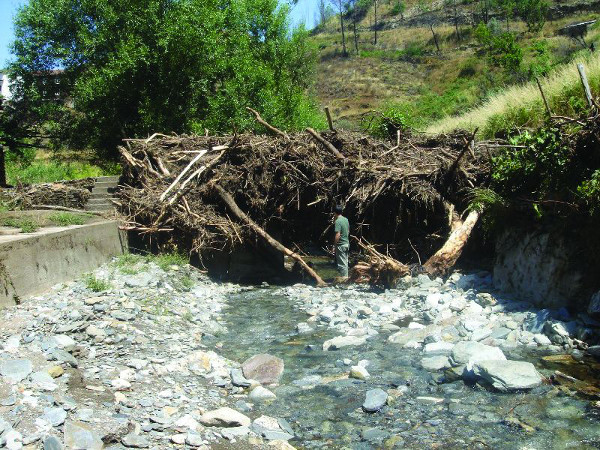
Figure 4: Wood accumulation following the wildfire at Sobral Magro, in the Pomares basin, Portugal, 2005 (Credit: L. Lourenço, Universidade de Coimbra, 2012)[7]
A 2014 report[6] lists potential water-related hazards a community might have to face after a wildfire, which may include the following hazards.
One concern is water turbidity, which refers to the load of solid particulates in the water, is a major concern for water-treatment plant filtering capacities. In addition, the amount of debris combined with unusually high water flow may damage water intakes and water-treatment infrastructures (Figure 4). The sediment load is also problematic as it gets deposited in human-made reservoirs in higher quantities than initially planned, which may reduce their life expectancy[8] (Figure 5).
Another concern is higher-than-normal concentrations of dissolved nutrients such as organic carbon, phosphorus, or nitrogen. Increased concentrations of those compounds increase the use of disinfectants that keep drinking water safe. This may temporarily raise treatment costs and concentrations of disinfection by-products (such as trihalomethanes) until the organics have been flushed from the watershed.
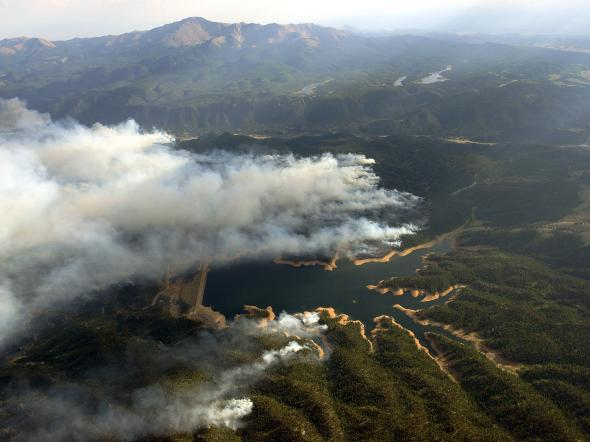
Figure 5: Rampart Reservoir during the Waldo Canyon fire in Colorado (Credit: John Wark, Reuters, 2012)
Several tools and methods exist to tackle post-fire hydrologic hazards; the best of which can be preventing wildfire from burning a watershed too often and/or too severely. When such a fire happens, the strategy usually consists of two main parts: identifying the most-likely upstream sources of post-fire pollutants using the capabilities offered by computer-assisted modeling and mapping, and intervening in burned areas with the deployment of post-fire treatments on the designated watershed hillslopes.
Different families of treatment exist including the application of a protective cover using mulch or helping vegetation recovery, the construction of erosion barriers (Figure 6), and the stabilization of river channels and roads[9].

Figure 6: A silt fence on a burned slope (Credit: New Mexico State Forestry, 2016)
The Alberta context
Generally, Alberta burns frequently and severely. In the period 2005-2014 almost 170,000 ha burned, on average, every year. In this context, learning to live with wildfires consequences is a reality and Alberta is leading the national effort to raise awareness about wildfire-induced risks to the water supply.
After the Lost Creek fire in 2003, many studies demonstrated changes in water chemistry potentially harmful for human health[10]. In 2012, a four year project funded by the Canadian Water Network enabled a team of researchers and managers to achieve a provincial scale study of the wildfire risk to the water supply. Since the Horse River fire in 2016, several research teams are gathering efforts to understand and limit the risk to the Fort McMurray water supply, which comes exclusively from the Athabasca River (Figure 7). This work includes using state-of-the-art technologies, with the hope new knowledge will help prevent further disturbances to a community in a high wildfire risk zone.
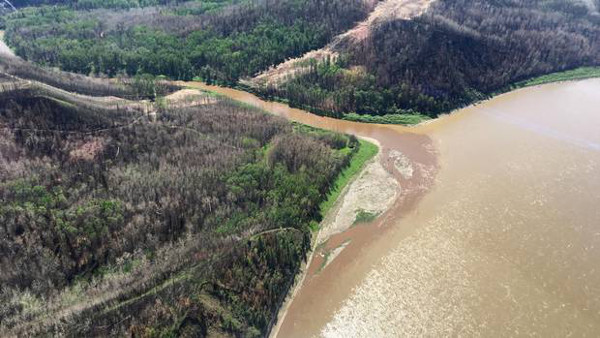
Figure 7: The mouth of the Horse River where it empties into the Athabasca River on June 10 after the first big rainfall event near Fort McMurray (Credit: The Globe And Mail, 2016)[11]
Although this post is focused on the surface drinking-water supply, post-fire hydrological hazards also affect other aspects of everyday life (e.g. recreation). Wildfire can affect vulnerable aquatic ecosystems by increasing turbidity, heavy metal and nutrient concentrations. Whenever water resources are threatened, the functioning of all living ecosystems can be disturbed.
In an era of global changes and climate extremes, humans are playing an ever-increasing role in wildfire occurrence and freshwater resource availability. Therefore, the nexus between wildfires, water, and societies — human and natural — deserves a better understanding[12] and future wildfire risks to the water supply in densely populated water basins need to be identified and properly managed[13].
Francois is currently a Ph.D Candidate, Western Partnership for Wildland Fire Science, at the University of Alberta. He kindly offered to author this blog following the release of How wildfires impact a watershed.
References
1. Millenium Ecosystem Assessment. Ecosystems and human well-being: Synthesis. World Resources Institute (Island Press, 2005). doi:10.1196/annals.1439.003
2. USDA. Wildland Fire in Ecosystems, Effects of Fire on Soil and Water. 4, (2005).
3. Shakesby, R. a. & Doerr, S. H. Wildfire as a hydrological and geomorphological agent. Earth-Science Rev. 74, 269–307 (2006).
4. Thompson, M. P. et al. Assessing Watershed-Wildfire Risks on National Forest System Lands in the Rocky Mountain Region of the United States. Water 5, 945–971 (2013).
5. Robinne, F. et al. A Global Index for Mapping the Exposure of Water Resources to Wildfire. Forests 7, 22 (2016).
6. Emelko, M. B. & Ho Sham, C. Wildfire Impacts on Water Supplies and the Potential for Mitigation : Workshop Report. (2014).
7. Lourenço, L., Nunes, A., Bento-Gonçalves, A. & Vieira, A. Soil Erosion After Wildfires in Portugal : What Happens When Heavy Rainfall Events Occur ? Res. Soil Eros. 1–24 (2012). doi:DOI: 10.5772/50447
8. Moody, J. a. & Martin, D. a. Wildfire impacts on reservoir sedimentation in the western United States. Proc. Ninth Int. Symp. River Sediment. 1095–1102 (2004).
9. New Mexico State Forestry. After Wildfires – a guide for New-Mexico communities. (2016). at <http://afterwildfirenm.org/post-fire-treatments>
10. Emelko, M. B., Silins, U., Bladon, K. D. & Stone, M. Implications of land disturbance on drinking water treatability in a changing climate: Demonstrating the need for ‘source water supply and protection’ strategies. Water Res. 45, 461–472 (2011).
11. Cecco, L. Fire and water. The Globe and Mail (2016). at <http://www.theglobeandmail.com/news/alberta/wildfires-have-major-impact-on-waterquality/article30512613/>
12. Martin, D. A. At the Nexus of Fire, Water and Society. Philos. Trans. R. Soc. Lond. B. Biol. Sci. this issue (2016).
13. Bladon, K. D., Emelko, M. B., Silins, U. & Stone, M. Wildfire and the Future of Water Supply. Environ. Sci. Technol. 48, 8936–8943 (2014).
